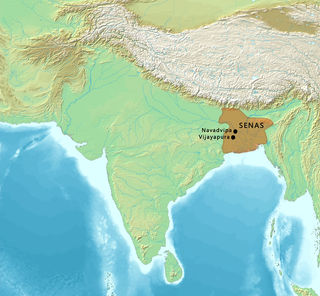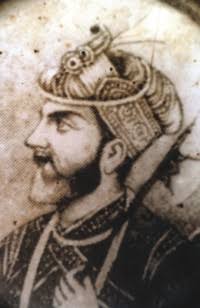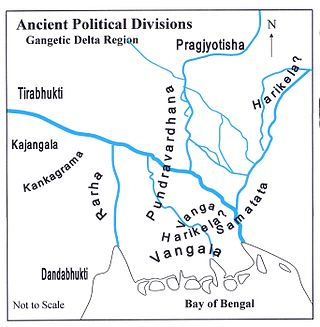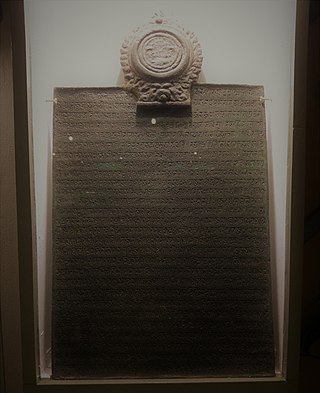Related Research Articles

The Sena dynasty was a Hindu dynasty during the early medieval period on the Indian subcontinent, that ruled from Bengal through the 11th and 12th centuries. The empire at its peak covered much of the north-eastern region of the Indian subcontinent. The rulers of the Sena Dynasty traced their origin to the south Indian region of Karnataka.

Isa Khan was the leader of the 16th-century Baro-Bhuiyan chieftains of Bengal. During his reign, he successfully unified the chieftains of Bengal and resisted the Mughal invasion of Bengal. It was only after his death that the region fell totally under Mughal control. He remains an iconic figure throughout West Bengal and Bangladesh as a symbol of his rebellious spirit and unity.

Manikganj is a district in central Bangladesh and part of the Dhaka Division. It was established in 1845, it was a subdivision of Faridpur District until, in 1953, it was transferred to Dhaka District for administrative purposes. In 1984, Manikganj was declared a full district.

Bogra District, officially Bogura District since April 2018, is a district in the northern part of Bangladesh, in the Rajshahi Division. Bogra is an industrial city where many small and mid-sized companies are sited. Bogra was a part of the Pundravardhana territory of ancient Bengal and the ruins of its capital can be found in northern Bogra.

The Chandra dynasty was a Buddhist dynasty, originating from the South East Bengal region of Indian subcontinent, which ruled the Samatata area of Bengal, as well as Arakan. Later it was a neighbor to the Pala Empire to the north. Rulers of Chandra kingdom were adherents of Buddhism. The Kings of Chandra dynasty were identified as the kings of Vangaladesha in the Tirumulai inscription of Chola dynasty. The dynasty was founded around the 4th century AD.

The Kamboja-Pala dynasty ruled parts of Bengal in the 10th to 11th centuries CE, after invading the Palas during the reign of Gopala II. The last Kamboja ruler of the Kamboja-Pala Dynasty Dharmapala was defeated by the south Indian Emperor Rajendra Chola I of the Chola dynasty in the 11th century.

Bikrampur was a pargana situated 19 kilometres (12 mi) south of Dhaka, the modern capital city of Bangladesh. In the present day, it is known as the Munshiganj District of Bangladesh. It is a historic region in Bengal and was a part of the Bhawal Estate.
Nayapala is the name of twelfth ruler of the Pala dynasty of eastern Indian Subcontinent, mainly the Bengal and Bihar regions. Nayapala, the son of Mahipala I, defeated the Kalachuri king Karna after a long struggle. The two later signed a peace treaty at the mediation of the Buddhist scholar Atiśa.
Vigrahapala II was the successor to the Pala king Gopala III in the Bengal region of the Indian subcontinent, and tenth ruler of the Pala line reigning for at least 12 years. He was succeeded by the famed Mahipala.
Vigrahapala III was the successor to the Pala king Nayapala in the Bengal region of the Indian subcontinent, and twelfth ruler of the Pala line reigning for 15 years. He was succeeded by Mahipala II.

Nāsir ad-Dīn Naṣrat Shāh, also known as Nusrat Shah, was the second Sultan of Bengal belonging to the Hussain Shahi dynasty. He continued with his father's expansionist policies but by 1526, had to contend with the Mughal ascendency in the Battle of Ghaghra. Simultaneously, Nasrat Shah's reign also suffered a reverse at the hands of the Ahom kingdom. The reigns of Alauddin Husain Shah and Nasrat Shah are generally regarded as the "golden age" of the Bengal Sultanate.

Harikela was an ancient kingdom located in the Bengal region of the Indian subcontinent. Originally, it was an independent township of ancient eastern Bengal, which had a continuous existence of about 500 years. The state of Harikal consisted of present-day Sylhet and Chittagong divisions of Bangladesh, as well as parts of the Tripura state of India.
Traillokyachandra was the first ruler of the Chandra dynasty in the kingdom of Harikela in eastern Bengal. His father, Subarnachandra, was a vassal to the earlier rulers of the Harikela Kingdom. Traillokyachandra established the dynasty, centered at Devaparvata and expanded into modern Kachua Upazila before declaring himself as Maharajadhiraja.
Srichandra was the second and most influential ruler of the Chandra Dynasty in eastern Bengal.
Kalyanachandra was the third ruler of the Chandra dynasty in eastern Bengal. His campaign against the Kamboja dynasty of northern Bengal allowed the resurgent Pala Emperor Mahipala I to reclaim much of the Pala Empire.
Govindachandra was the last known ruler of the Chandra dynasty in eastern Bengal.

ʿAlā ad-Dīn Fīrūz Shāh was the son and successor of Sultan Nasiruddin Nasrat Shah of Bengal. He served as a governor of Chittagong during his father's reign, and was a patron of Bengali literature. Firuz Shah ascended the throne in 1533, though it was not unanimously recognised by all the nobles of Bengal. The conflict with the Ahom kingdom continued during his reign and the Bengali army led by Turbak Khan had reached as far as Kaliabor. Within three months as Sultan, Firuz Shah was assassinated by his uncle, who succeeded him as Sultan Ghiyasuddin Mahmud Shah.
Ashrafuddin Ahmad Chowdhury was a Bengali politician who had served as general secretary of the Congress Party's Bengal branch, member of the East Bengal Legislative Assembly and later as the education minister of Pakistan. He was an advocate of Huseyn Shaheed Suhrawardy's United Bengal proposal.

The Pahcimbhag copperplate inscription, Srichandra Paschimbhag copperplate inscription or simply Chandrapur inscription is a copperplate inscription issued in 935 by Srichandra, the second king of the Chandra Dynasty of south-east Bengal. The inscription was discovered in the village of Paschimbhag, Moulvibazar district. It is one of 12 known copperplate inscriptions by Chandra Dynasty kings. The inscription is mainly a deed of donation, in which Srichandra grants lands for many Brahmins and for nine monasteries in the Sylhet region, which formed Chandrapur University, named after Srichandra. It includes a detailed description of the Chandra kingdom and the Palas and Kamboja Pala rulers of Bengal and refers to the society of pre-medieval Bengal.
Abdul Momin Chowdhury was a Bangladeshi historian and academic. He was the Vice-chancellor of the National University of Bangladesh and Primeasia University, Bangladesh. He also served as the President of the Bangladesh History Association and the Asiatic Society of Bangladesh.
References
- ↑ Chowdhury, AM (2012). "Chandra Dynasty, The". In Islam, Sirajul; Jamal, Ahmed A. (eds.). Banglapedia: National Encyclopedia of Bangladesh (Second ed.). Asiatic Society of Bangladesh.
- Singh, Nagendra Kr. (2003). Encyclopaedia of Bangladesh. Anmol Publications Pvt Ltd. pp. 7–21. ISBN 81-261-1390-1.
- Chowdhury, Abdul Momin (1967). Dynastic History of Bengal. Dacca: The Asiatic Society of Pakistan.